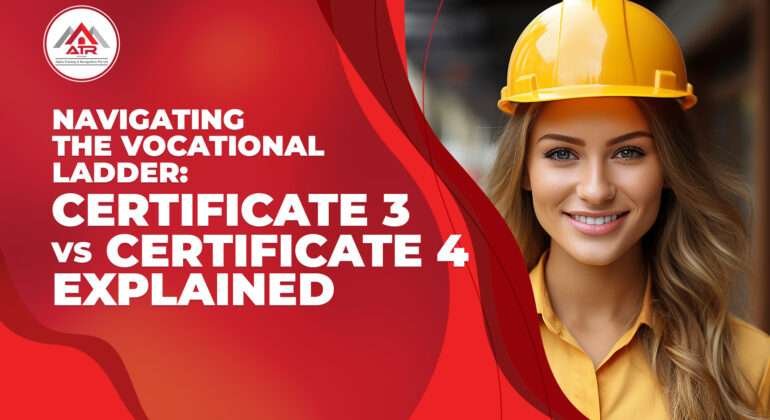As dawn breaks over the vast Australian continent, thousands of individuals rise to the call of progress. Their boots are laced, their spirits high, and their minds thirsty for knowledge.
These are the aspiring tradespeople, healthcare workers, hospitality enthusiasts, and countless others whose hearts are set on conquering the rugged terrains of practical occupations.
In the heart of the Land Down Under, vocational education has been carving out paths in the wild outback of career choices for decades, guiding those intrepid enough to seek roads less travelled. Within this rich tapestry of education, two luminous beacons stand tall – Certificate 3 and Certificate 4.
Imagine, if you will, a landscape as diverse as the eucalyptus forests of Tasmania and the sandy deserts of Western Australia. This is the world of vocational education. A realm where skills are the currency and practical knowledge is the compass guiding you through the wilderness of career choices.
Here, individuals from all walks of life can find their place under the sun. From the high school graduate whose hands long to build to the seasoned professional seeking new pastures; vocational education knows no bounds.
At the core of this boundless land, Registered Training Organisations (RTOs) are the custodians. Like the age-old indigenous wisdom passed through generations, RTOs are the keepers and sharers of practical knowledge.
They are the builders of bridges between dreams and reality. RTOs have honed the craft of sculpting raw ambition into finely tuned skills, and within their arsenal, Certificate 3 and Certificate 4 are the chisels and hammers of creation.
Certificate 3, in essence, is the spirited cockatoo of the vocational realm – vibrant, accessible, and dexterous. It is the first whisper of dawn that beckons the seekers onto the paths of their chosen trades. The welcoming embrace that assures you,
“You belong”. It is the foundation upon which skyscrapers of ambitions can be built and the wind beneath the wings for those taking their first flight into the workforce.
On the horizon, Certificate 4 emerges like the wise kangaroo, strong and far-sighted. It is the vessel that carries you across deeper waters, where waves of management and specialized skills challenge the shores of the basic.
For those whose eyes are set on vistas beyond the immediate, Certificate 4 is the trusted steed that carries them over the rugged terrain of supervisory roles and specialized expertise.
As we stand at the crossroads, with the eucalyptus-scented winds of the vocational outback in our hair, it is paramount to know the companions of our journey. Certificate 3 and Certificate 4 are more than mere parchment and ink; they are the echoes of ancestral wisdom and modern innovation, woven seamlessly into tapestries that can adorn the halls of our professional destinies.
Together, let’s embark upon this journey through the rugged, beautiful landscape of vocational education in Australia, understanding the ethos of Certificate 3 and Certificate 4, and unraveling how these powerful instruments can shape the symphony of our careers.
When you think of education, the imagery of universities and degrees might flood your mind. However, allow me to introduce you to the unsung heroes – Certificate 3 and Certificate 4 in vocational education.
These mighty certs, as I affectionately call them, are like your “Career Swiss Army Knives”. Today, let’s delve into the treasure trove of Vocational Education and Training (VET), and get our hands dirty dissecting these certs that are carefully crafted by Registered Training Organisations (RTO).
When it comes to vocational education, the Land Down Under has a tale to tell. Back in the 1970s, TAFE (Technical and Further Education) entered the scene like a knight in shining armour. With TAFE and subsequently RTOs, the seeds for Certificates 3 and 4 were sown.
Demystifying Certificate 3
Picture this – Certificate 3 is like a hearty meat pie. It’s wholesome and gives you just what you need to not be hungry for skills. Targeting the backbone of industries, it provides the essential ingredients for job-specific competencies. From automotive mechanics to aged care, it’s the first trusty rung on your career ladder.
Certificate 4 Unveiled
Now imagine Certificate 4 as the quintessential Australian BBQ. There’s a variety of skill meats on the grill, allowing you to not only savour the basics but also relish the more specialised roles. Whether it’s supervisory skills in construction or advanced beauty therapy techniques, Certificate 4 adds that spice to your career portfolio.
The Great Divide: Comparing Certificate 3 and Certificate 4
Think of Certificate 3 as your trusty ute; it’s practical and gets the job done. Certificate 4, on the other hand, is akin to an SUV – with more features and comforts for those longer career journeys.
The course duration for Certificate 4 is usually longer, mirroring the depth it covers compared to Certificate 3. Moreover, Certificate 4 often requires the foundational know-how, a la Certificate 3, or relevant work experience.
Certificate 3 and Certificate 4 are both commendable qualifications in the Australian Vocational Education and Training (VET) sector. However, like kangaroos and wallabies, though similar, they have distinct characteristics. Let’s decode these differences into major and minor ones.
Major Differences:
Skill Depth and Complexity:
Certificate 3: It’s the jack-of-all-trades. Imagine it as a freshly baked damper bread – fundamental, wholesome but basic. It equips you with the core skills needed for entry-level positions.
Certificate 4: Picture this as a well-crafted pavlova – intricate and layered. It’s about more advanced skills and knowledge, often preparing you for supervisory and management roles.
Entry Requirements:
Certificate 3: Typically, no prerequisites are required. It’s like diving into a pool with both feet; just jump in.
Certificate 4: Sometimes, having a Certificate 3 or relevant industry experience is necessary. Think of it as needing a snorkel set before you go snorkeling.
Course Duration:
Certificate 3: Usually shorter in duration, like a friendly T20 cricket match.
Certificate 4: Tends to be longer, akin to a classic test cricket match, allowing for more in-depth exploration of subjects.
Career Prospects:
Certificate 3: Provides the groundwork for entry-level positions – the foot soldiers of the industry.
Certificate 4: Prepares you for higher positions, like becoming the captain of your industry team.
Minor Differences:
Assessment Criteria:
Certificate 3: Generally involves more practical assessments. Think of it as learning how to make the perfect flat white coffee.
Certificate 4: Often incorporates a blend of practical and theoretical assessments – like not just making the coffee, but running the café.
Learning Environment:
Certificate 3: More often hands-on and practical; it’s about getting your hands dirty in the workshop.
Certificate 4: A mix of hands-on and classroom learning, akin to dividing your time between the workshop and the design room.
Networking Opportunities:
Certificate 3: Provides a good base for building your network, like gathering friends for a beach barbie.
Certificate 4: Often offers wider networking opportunities, akin to an invigorating community BBQ festival.
Cost:
Certificate 3: Generally more affordable, like buying a boomerang for some backyard fun.
Certificate 4: Might be a bit more of an investment, like getting that elite-grade boomerang for professional tournaments.
In essence, Certificate 3 is like your sturdy 4WD for the rough terrains, whereas Certificate 4 is akin to an all-equipped caravan for an expansive outback journey. Both are invaluable but serve different purposes on the vocational adventure trail.
Selecting the Right RTO
Choosing an RTO is like picking the right pair of footy boots – it can make or break your game. Research the RTO’s accreditation, chat with alumni, and make sure it aligns with your goals.
Stepping Stones: Progressing from Certificate 3 to Certificate 4
Progressing from Certificate 3 to Certificate 4 is like going from playing footy in the backyard to joining a local club. It’s about upping your game. Most people start with a Certificate 3 to gain the essential skills and then move on to Certificate 4 for specialised skills or supervisory roles.
Real-life Examples: Success Stories
Meet Sarah, a spirited soul who embraced Certificate 3 in Early Childhood Education. With this, she became a supernanny. Eager to elevate her prowess, she pursued Certificate 4, and now, she’s orchestrating an entire fleet of nannies like a maestro.
We also have Tom, a car enthusiast. He harnessed the power of Certificate 3 in Automotive Mechanical Technology. He started as a mechanic in a local garage, fondly known as “The Wrench Wizard”. Craving more, he dove into Certificate 4 in Automotive Management, and now, he owns a chain of garages.
Conclusion
As the sun sets over the mesmerising plains of our vocational odyssey, we find ourselves at the culmination of an enlightening exploration through the rugged terrain of Certificate 3 and Certificate 4 in vocational education.
Through this winding trail, we have trekked the steep climbs of skill acquisition, crossed the rivers of career prospects, and paused to breathe in the air of knowledge that permeates this untamed landscape. Like explorers having navigated the vast outback, we’re now well-equipped with invaluable insights to chart our course forward.
Certificate 3, as we now fathom, is akin to the sturdy roots of the towering gum tree. Embedded deep within the fertile soil of fundamental skills, it provides the nurturing bedrock for fledgling ambitions to take root.
It’s the gentle whisper in the wind, coaxing you to spread your wings, but remain close to the comforting embrace of the foundational canopy.
In contrast, Certificate 4 stands tall like the summit of the majestic Uluru, calling forth those yearning for the panoramic vistas of specialized knowledge and leadership. It challenges the wanderer within, to not just traverse the terrain but also leave imprints for others to follow.
The winds at this summit whisper tales of innovation, perseverance, and the audacious dreams that have shaped the skylines of industries.
However, as the stars begin to adorn the night sky, let us not forget the unsung heroes of this journey – the Registered Training Organisations (RTOs). Like the constellations guiding the mariners of yore, RTOs have been the compass and sextant for countless aspirants venturing into the sea of vocational education.
They have been the custodians of trust, excellence, and the timeless tradition of hands-on learning that has forged the backbone of the Australian workforce.
Now, as we prepare to set sail on the waters of our chosen careers, may we be ever cognizant of the powerful vessels we commandeer – be it the agile dinghy of Certificate 3 or the commanding galleon of Certificate 4.
Our choices here are neither the beginning nor the end, but rather waypoints in the continuous voyage of self-improvement and professional growth.
We must remember that every skill we acquire is a precious gemstone added to the treasure chest of our capabilities; each practical experience is an indelible ink in the maps of our careers.
The tapestry we weave through the choices we make here will be our legacy – a reflection of our aspirations, grit, and the audacity to etch our destinies in the annals of vocational mastery.
As the echoes of Certificate 3 and Certificate 4 reverberate through the eons, let them find a symphony in the songs of our achievements.
Let our endeavours be the guiding lighthouses for the generations that follow, and let the chapters we pen in the volumes of vocational education be remembered as the verses of dreamers, creators, and trailblazers.
In conclusion, may your Certificate 3 be the sturdy mast that weathers the storms, and may your Certificate 4 be the sails that catch the winds of boundless opportunities. Steer your vessel with wisdom, navigate with courage, and let the stars of your dreams be the compass that guides you to the shores of fulfilment.



